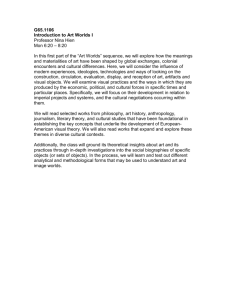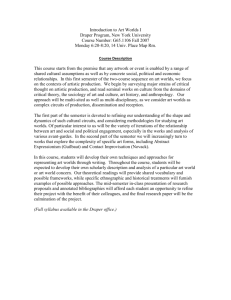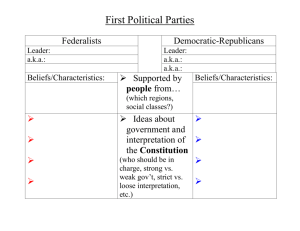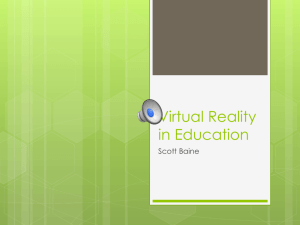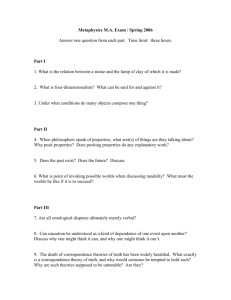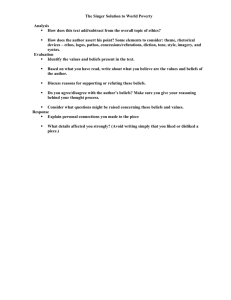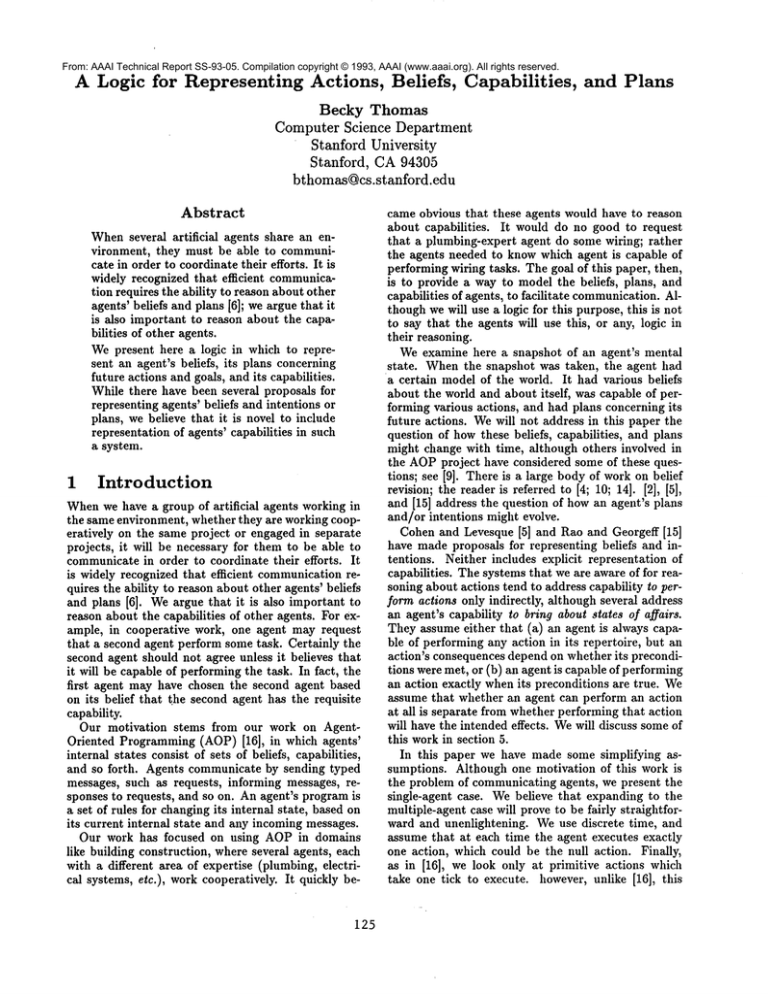
From: AAAI Technical Report SS-93-05. Compilation copyright © 1993, AAAI (www.aaai.org). All rights reserved.
A Logic for Representing
Actions,
Beliefs,
Capabilities,
and Plans
Becky
Thomas
Computer Science
Department
Stanford University
Stanford,
CA 94305
bthomas@cs.stanford.edu
Abstract
Whenseveral artificial
agents share an environment, they must be able to communicate in order to coordinate their efforts. It is
widely recognized that efficient communication requires the ability to reason about other
agents’ beliefs and plans [6]; we argue that it
is also important to reason about the capabilities of other agents.
Wepresent here a logic in which to represent an agent’s beliefs, its plans concerning
future actions and goals, and its capabilities.
While there have been several proposals for
representing agents’ beliefs and intentions or
plans, we believe that it is novel to include
representation of agents’ capabilities in such
a system.
1
Introduction
Whenwe have a group of artificial
agents working in
the same environment, whether they are working cooperatively on the same project or engaged in separate
projects, it will be necessary for them to be able to
communicatein order to coordinate their efforts. It
is widely recognized that efficient communicationrequires the ability to reason about other agents’ beliefs
and plans [6]. Weargue that it is also important to
reason about the capabilities of other agents. For example, in cooperative work, one agent may request
that a second agent perform some task. Certainly the
second agent should not agree unless it believes that
it will be capable of performing the task. In fact, the
first agent may have chosen the second agent based
on its belief that the second agent has the requisite
capability.
Our motivation stems from our work on AgentOriented Programming (AOP) [16], in which agents’
internal states consist of sets of beliefs, capabilities,
and so forth. Agents communicate by sending typed
messages, such as requests, informing messages, responses to requests, and so on. An agent’s program is
a set of rules for changing its internal state, based on
its current internal state and any incoming messages.
Our work has focused on using AOPin domains
like building construction, where several agents, each
with a different area of expertise (plumbing, electrical systems, etc.), work cooperatively. It quickly be-
125
came obvious that these agents would have to reason
about capabilities.
It would do no good to request
that a plumbing-expert agent do some wiring; rather
the agents needed to know which agent is capable of
performing wiring tasks. The goal of this paper, then,
is to provide a way to model the beliefs, plans, and
capabilities of agents, to facilitate communication.Although we will use a logic for this purpose, this is not
to say that the agents will use this, or any, logic in
their reasoning.
Weexamine here a snapshot of an agent’s mental
state. Whenthe snapshot was taken, the agent had
a certain model of the world. It had various beliefs
about the world and about itself, was capable of performing various actions, and had plans concerning its
future actions. Wewill not address in this paper the
question of how these beliefs, capabilities, and plans
might change with time, although others involved in
the AOPproject have considered some of these questions; see [9]. There is a large body of work on belief
revision; the reader is referred to [4; 10; 14]. [2], [5],
and [15] address the question of howan agent’s plans
and/or intentions might evolve.
Cohen and Levesque [5] and Rao and Georgeff [15]
have made proposals for representing beliefs and intentions. Neither includes explicit representation of
capabilities. The systems that we are aware of for reasoning about actions tend to address capability to perform actions only indirectly, although several address
an agent’s capability to bring about states of affairs.
They assume either that (a) an agent is always capable of performing any action in its repertoire, but an
action’s consequences depend on whether its preconditions were met, or (b) an agent is capable of performing
an action exactly when its preconditions are true. We
assume that whether an agent can perform an action
at all is separate from whether performing that action
will have the intended effects. Wewill discuss some of
this work in section 5.
In this paper we have made some simplifying assumptions. Although one motivation of this work is
the problem of communicating agents, we present the
single-agent case. Webelieve that expanding to the
multiple-agent case will prove to be fairly straightforward and unenlightening. Weuse discrete time, and
assume that at each time the agent executes exactly
one action, which could be the null action. Finally,
as in [16], we look only at primitive actions which
take one tick to execute, however, unlike [16], this
logic was designed with the expectation that it would
be extended to handle higher-level actions built from
lower-level ones (see [12] for a description of howthis
might be done). These higher-level actions obviously
may take longer to execute. Wewill say more in section 5 about this extension.
The rest of this paper is organized as follows: in section 2 we discuss the basic temporal logic we will use.
Section 3 presents our model of actions, and section 4
presents operators for beliefs, capabilities, and plans.
In section 5 we discuss related work and the effects
of relaxing some of the assumptions mentioned above.
Section 6 is a concluding summary.
2
Base Language
Ourbaselanguage
is a propositional
temporallanguage.
SyntaxWe havea set of time symbolsT and a set
of propositional
symbols
P.
¯ If tl, t2 E T then tl < t2 is a wiT.
¯ If p C P and t E T then pt is a wff.
¯ If tl,t 2 E T and Otl is a wff then rlt2Otl is a
wff.
¯ If @tand 9t are wits then so are _,Or and ¢t AC/t.
By
1 ntl¢t2 we mean that it is the case at time t
that ~ will be (or is, or was) true at time 2 no matter
what else may happen between t I and t 2. Notice that
¢tlAf/t2 is a legal sentence only if tl=t 2. Wedefine
V, -% and 0 as usual.
Semantics We have a set Wof worlds, each with a
unique associated time. Our basic semantic structure
is a capability tree, which is a collection of worlds and
a precedence relation over them. Intuitively, a tree is
well-formed if only forward branching is allowed and
every branch extends infinitely far into the past and
future. Wedo not require that the structure be connected, so a more proper name would be a "capability
forest," but for most of this paper we will assume a
tree.
Formally, a capability tree is a tuple
(W, T, <, timeOf , pred, ~r) where
¯ Wis an infinite set of worlds,
¯ 1,
T is an infinite set of times
¯ < is a total order on times,
¯ timeOf is a function from worlds to times,
¯ pred is a function from worlds to worlds (from
each world to its unique predecessor in the tree),
where
- 1timeOf(pred(w)) + 1 = timeOf(w)
1For this paper, we will assumeT is the integers, but
this choiceis not forced on us.
126
- Vw3wl.wl = pred(w) AVw3wz.w = pred(w2)
- pred*(w)de__.f
{w’I w’ = w or w’ e prea*(pred(w))}
¯ r is a truth function which maps each (p,t) pair
(where p is a primitive proposition and t is a time)
into the set of worlds with associated time t where
p is true.
Wesay that one world is reachable from another if
there is some temporally monotonic path between
them in the tree; that is,
reachable(Wl,W2) =_ 1 Epred*(w2) orw2 ¯ pred*(wl).
Finally
we define
a function
rat (for
reachable-at-time):
rat(w, t) = {wt l reachable(w’, w) and timeOf(w’) = t}.
Wenow define what it means for a pair M, w to
model a sentence (where M is a capability tree and
w¯ W):
¯ M,w
< t2 iff zl,t2 ¯ T and tl < t2. 2
pt iff w¯ ~r(p,t).
_~¢t iff timeOf(w) = and M,w ~¢t .
¯
@tA~t
¯ M,w
¯ M,w
M,w
iffM,
w~Ot andM,
w~t.
* M, w ~ [:]tl @t2 iff timeOf(w) = tl and for every
w~ ¯ rat(w, t2), it is the case that M, w~ ~ qt2.
So our modelof the agent’s environment is a tree (or
forest) with manypossible futures. If the agent is using
this model to reason at time t, then it maybe that all
the branching in the tree takes place after t, since the
present and the past are completely determined. Note
that this is not to say that the agent has complete
knowledge of the present or past, as we will see in
section 4.1.
3
Actions
An action is a function from a world to a set of
worlds. For example, let us consider an action a. Suppose that applying a to world w gives us a set S of
worlds. If our agent performs action a in world w (and
timeOf(w) = t) then at time t + 1 the agent will be in
one of the worlds in S. Which of those worlds is the
actual resulting world may depend on such external
factors as chance or the actions taken by other agents.
As mentioned in section 1, we will consider only
primitive actions, each taking exactly one unit of time
to execute. Weassume our agent performs exactly one
action at each time, and that one available action is
the null action. Wediscuss relaxing these assumptions
in section 5.
2Wewill adopt the convention of using typewriter
font for syntactic objects and math font for semantic objects. Whena syntactic object and a semantic object have
the same name, it is to be understood that our interpretation mapsthe one to the other. Throughoutthis paper,
wewill leave the interpretation implicit.
Syntax Wehave a set A of primitive actions. If a E A
and t E T then did(t,a) is a wff. (For consistency
notation, we will write this wff as didt (a).) t (a)
is true iff the agent has just finished performing action
a at time t.
Semantics
We add to our model a set A of
functions3;
if a E A then a : W ~ 2W. If A =
{al,a2,...,an}
and w E Wthen
¯ ai(w) C_{w’ Iw=pred(w’)},
l<i<n,
¯ ax(w)Ua2(w)U...Uan(w) = {w’ I w =pred(w’)},
and
¯ ai(w) Naj(w) = 0 ifi # j.
This last requirement, that the results of different actions be completely disjoint, may seem overly constraining at first. However,worlds resulting from different actions will always be distinct if only by virtue
of the did predicate, whose meaning we now define:
¯ M, w ~ did t (a) if[ timeOf(w) = and
w E a(pred(w)).
Fromthese definitions, we have the following:
Proposition 1 The following sentences are valid:
¯ didt (a1 ) Vdidt (a2) V.. -Vdidt (an)
¯ -~(didt (ai)Adidt (aj)),
i # j.
Notice that, due to the branching time structure we
are using, we can say what has happened in the past,
but the only way we can talk about the future is by
saying what is true in every possible future (or in some
possible future). That is, there is a fact of the matter
about the past, but the future is yet to be determined.
Intuitively, this is why we included didt (a) in our
language rather than for example doest (a). There
a fact of the matter about what the agent just did.
Whether the agent will perform some action is a question that we cannot answer without peering into the
future, and whether an agent plans to perform some
future action is a question about the agent’s mental
state, not about the world.
4
The Agent’s Mental State
Nowthat we have a way of talking about the agent’s
environment, we turn to describing the agent. Werepresent the information the agent possesses about itself
and its environment as a set of beliefs. The actions
it has available to it and the states of affairs it can
bring about by performing these actions are described
in terms of its capabilities. Finally, the actions that
the agent means to perform and the states of affairs
it means to bring about are described in terms of its
plans.
Rememberthat we are looking only at a snapshot of
the agent’s internal state and will not address the question of howits beliefs, capabilities, and plans evolve
over time.
3See footnote 2.
127
4.1 Beliefs
Weadd a modal operator representing belief. Wewill
leave open the precise choice of modal system, as this
decision may depend on characteristics
of the domain
or the agents. For example, for an agent whose reasoning consists of theorem-proving, and whose beliefs are
just the axioms contained in its knowledge base, the
axioms of positive and negative introspection would
probably be appropriate. Wewill insist, however, that
the agent cannot believe contradictions.
Weuse a standard possible-worlds model. Wehave a
collection of accessibility relations Bt, one for each t E
T. Theseaccessibility relations are just sets of ordered
pairs of worlds. If we have a forest of unconnected
capability trees, accessible worlds are not required to
be in the same tree. (Belief is the only operator for
which other trees in the forest might be relevant.)
Syntax
wff.
If~ tl
isawffandt
2 ETthenBt2~tl
isa
Semantics For each t E T, we add to our model
Bt C_ 2 W’xw, where Wt = {w [ w E W and
timeOf(w) = t}. For every world w E Wt’ and every t2 E T, there exists some w’ E Wt2 such that
(w, w’)~ t’.
¯ M,w ~ Btlet2 iffw E Wtl and for all t2
w’ E W
such that (w, w’) Bt ’, M,w’ ~¢t2.
Fromthese definitions, we have the following:
Proposition 2 The following sentences are valid:
K Btl%%t2ABtl(%%t2--+c/t2)--,BtlC/t2.
D ~Btl falser2.
That is, the agent is logically omniscient (a wellknown problem with possible-worlds models of belief) and never believes contradictions. As mentioned
above, we can choose other semantic restrictions
to
suit a particular application. For more about modal
systems for belief, see [7].
In addition, we will place a few more constraints on
Bt:
¯ If (wl,w2) Bt andtime Of(wl) = ti meOf(w2),
then Wl e a(pred(Wl)) iff w2 E a(pred(w2)) for
every a E A.
¯ If (wl,w2) E tl, ( w2,w3) EBt 2, and tl < t 2,
then (wl,w3) E tl.
¯ If (wl, w2) Bt ’ th en (wl,pred(w2)) q t~.
¯ If (Wl,W2) Bt ~ th en (wl,w3) E
e {wlw= pred(w)}.
t~ for some
From these constraints, we have
Proposition 3 The following sentences are valid:
¯ didt (a)------Btdid t (a).
¯ (t 1 <_t2)--.(Bt 1 @t’--+Bt1 Bt2 ~t’).
¯ Btll-lt2~t3 _.. Btl~t3.
¯ Btl@t2.-~ BtloZ34Z2.
The first says that the agent always knows what
action it just performed, and the second that the agent
believes that its current beliefs will persist. The third
and fourth specify the relationship between the belief
operator and the necessity and possibility operators.
Since we are only discussing a snapshot of the
agent’s mental state, we will not discuss how the
agent’s beliefs actually evolve as time passes. This
is an important and difficult problem, as the literature
on belief revision attests. As seen above, however, we
can examine the agent’s current beliefs about its future beliefs, and indeed about all aspects of its future
mental state. Others who work on the Agent Oriented
Programmingproject have considered the evolution of
beliefs under a constraint of minimal learning; see [9].
4.2
Capabilities
Wewill examine two types of capability: CanDo,which
applies to actions, and CanAch(for "can achieve"),
which applies to sentences. It is important to keep
these two types of capability separate, and a planning
agent will want to be able to reason about both. An
agent will consider whether it CanAcha proposed goal
4 in deciding whether to adopt 4 as a goal. If it provably cannot achieve 4, then it should not adopt the
goal. If 4 is being considered as a means of achieving
some higher-level goal ~ then the agent should seek
other means of achieving ~. Reasoning about whether
it CanDoa given action, on the other hand, usually occurs when the agent is seeking means to achieve goals
which have already been adopted.
By CanDot (a), we mean that the agent can perform
t 4t’ we mean
action a at time t. Whenwe say CanAch
that the agent is capable (at time t) of someseries
actions which will guarantee that 4 will be true at time
t’, no matter what else happens between t and t’.
Syntax If a E A, t 1 E T, and 4t2 is a wit then
CanDotl (a) and CanAchtl4t2 are wffs.
Semantics Wedefine
So an agent is capable of an action if there is at least
one world which might result from the performance of
that action. The agent is capable of achieving some
state of affairs 4t if either it is now time t and 4
is true, or there is a series of actions, not necessarily
tcontiguous, which would if performed guarantee 4
and furthermore the agent is capable of performing all
of these actions in the appropriate situations. This
definition is quite strong, as it requires that the agent
be able to bring about 4t no matter what other events
might happen in the meantime.
Wewill just point out that an obvious extension to
the language we have presented thus far is to allow
quantification over actions. In that case, we might
tchange the second disjunct of the definition of CanAch
to be:
¯ t I < t2 and M,w ~ CanAchtl
(3 a.CanDot2 -1 (a)ADt2-1(didt2 (a)-+4t2)),
which would say the agent is capable of achieving 4 if
there is some(possibly conditional) plan for achieving
4; that is, which action the agent takes may depend
on which world the agent ends up in. However, for this
paper, we will allow only linear plans.
From the above definition, we have
Proposition 4 The following 8ententes are valid:
¯ CanDot (a)--Otdid t+l (a).
¯ did t (a)-~[3tganDo t-1 (a).
¯ [3t 14t2-+CanAcht 14t2.
¯ CanAchtl 4t2--+Otl 4t2.
¯ -~CanAcht t’.
false
¯ CanDot (a)=CanAchtdid t+l (a).
¯ t l<t 2--*-~CanAcht24t 1.
Notice that we get axiom D for CanAch, but not
axiom K. In particular, CanAchtl (4t2 A-~4t2) is not
satisfiable,
but CanAchtl 4t2 ACanAchtl-~4t2 is.
4.3
Plans
Weintroduce three operators, PD, PND,and PAfor representing the agent’s plans. The abbreviations stand
for "plan to do," "plan not to do," and "plan to
achieve," respectively.
We are not using the word
"plan" in the typical AI sense of the word. Following the usage of [1], by "plans to ..." we mean not
just that the agent in question knowsabout a plan, but
that the agent meansto carry out (a particular instantiation of) that plan. As mentioned above, in this paper we limit our agent to linear plans; in a later paper,
we will discuss conditional plans as well. Since in this
paper we are examining only a snapshot of the agent’s
mental state, we will not here address the question of
how the agent’s disposition to execute the planned action(s) persists, although this persistence is obviously
central to the usefulness of making plans. (For more
on the usefulness and uses of plans, see [13]).
CanDo and CanAch as follows:
¯ M,w~ CanDot (a) iff timeOf(w) ---- and th ere
exists w’ such that w’ E a(w).
¯ M, w ~ CanAchtl 4t2 iff
- t 1 = t 2 and M,w ~4t2, or
- t 1 < t 2 and there exists a E A such that
]~/, w ~ CanAchtl (CanDot2-1 (a)
at2-1 (didt 2 (a)-~4t2))4, or
- there exists t’ such that t I _< t~< t 2 and
/~1F, w ~ CanAchtl []t’4t2.
4Of course we have not defined temporal terms like
"t-l;" but we can replace t-1 with t’ and conjoin (t’<
t ^(t"
< t ~t"_<t’)).
128
Syntax If a E A, t I E T and 4tt2 is a wff then
pDtl (a), PNDtl (a), and PArlOr2 wffs.
Semantics Weadd to our model an accessibility
relation 7) over worlds. Werequire that if (w, w’) E
then w = pred(w’), and we further require that 7) be
serial (so there is always some7)-accessible world).
other words, for each world, 7) picks out some of its
successor worlds.
¯ M,w ~ PDt (a) iff for all worlds I s uch t hat
(w,w’) E 7), M,w’ ~ didt+l (a).
t (a) iff for all worlds w’ such that
¯ M, w ~ PND
¯ If (Wl,W2) ¯ ~t and timeOf(wl) = timeOf(w2)
then there exists a w3 such that (wx,w3) ¯
and w3 ¯ a(wa) iff there exists a w4 such that
(w2,w4) ¯ 7) and w4 ¯ a(w2), for all actions
From these conditions, we get
Proposition 6 The following sentences are valid:
¯ BtlPDt2 (a)-*Btldidt2 +1 (a).
¯ BtlPNDt2 (a)--*Btl-~didt2 +1 (a).
¯ PDt (a)=BtpD t (a).
t (a).
¯ PNDt (a)----BtpND
¯pAtl ~t2-~Btl~t2.
(w,w’) E 7), M,w’ didt+l (a
).
¯ M,w ~ phtl~t2iff
- t 1 = t 2 and M,w ~Bt2@t2, or
- t 1 < t 2 and there exists a E h such that
M, w ~ pAtl (pDt2 -1 (a)A
Dr2 -1 (didt2 (a) --*~t 2 )),
- there exists t’ such that t 1 < tt< t 2 and
M,w ~ phtl [3t’~t2.
Notice that the definition of the PAoperator looks similar to the definition for CanAch,although it includes
an additional belief operator. This difference emphasizes the fact that the agent’s capability depends on
the world, while the agent’s plans are entirely "mental" phenomena. According to the definition of PD,
for every world in the agent’s model, there is at most
one chosen action that the agent plans (in the current snapshot of the agent’s mental state) to perform,
should it ever find itself in that world. For some
worlds, the agent may not plan to perform any particular action. On the other hand, there may be many
actions which an agent plans not to perform. (In fact,
if ]A ] = n then there may be as manyas n - 1 actions
which the agent plans not to perform.)
From the above definitions, we have:
Proposition 5 The following sentences are valid:
t (a).
¯ PDt (a)-~CanDo
I; (a)-4PND
t (a).
¯ ~CanDo
t
t
t I ¢t2.
¯ pA i @t2-~BI Canhch
t
t’.
¯ ~PA false
t (aj), i~j.
¯ PDt (ai)-~PND
t (a)).
¯ ~(PDt (a)APND
t
t (a 1 ) -~PDt(an)
¯ PND (aI ) A...APND
n_
(where A -- {al, a2,..., a,}).
¯ PDt (a)--+Phtdid t+l (a).
¯ Phtdid t+l (a)-*(PD t (a)VBtOtdidt+l
(a)).
In addition, we will now place further semantic restrictions on the relationship between the belief relation Bt and our new relation 7):
¯ If (Wl, W2)¯ ~t then (pred(w2), w2) ¯ ~.
129
Again,it is outside
thescopeof thispaperto considerhowtheagent’s
plansevolve,
andthisisa complicatedquestion.
Whileit seemsclearthatplansshould
tendto persist,
it alsoseemsclearthattheyshould
sometimes
be reconsidered.
Thereaderis referred
to
thediscussions
ofthispoint
in[2;13;5].
Noticethatalthough
we cansaywhenan agenthasa
planforachieving
somestateofaffairs,
we donotnecessarily
knowwhatthatplanis.Furthermore,
plans
arenotobjects
in ourlanguage,
thewayactions
are.
We believe
thattheplanoperators
defined
abovewill
suffice
fordescribing
theagents
we areinterested
in.
Theseagentswillbe described
in a paperto appear
on the agentorientedprogramming
languagePLACA
(whichstandsfor PLAnningCommunicating
Agents).
5
Discussion
Work
and Related
In [15], Rao and Georgeff present a logic for beliefs,
goals, and intentions. For them, goals are states of
the world that the agent desires and has chosen, while
intentions are goals that the agent is committedto realizing. Our PlantoDoand PlantoAch
operators are
meantto capture
something
slightly
different
fromeither.Forus,an agentplanstoachieve
some@ if it not
onlyhaschosento pursue@ butalsohasconstructed
a plan for achieving @and means to carry out that
plan. Rao and Georgeff use a branching time structure
rather like ours, in which actions (or events) movethe
agent from one situation (our worlds) to another;
their system as in ours an agent can attempt some action but fail to bring about the desired effects. They
examine the evolution of intentions, once formed, while
we model only the static mental state of an agent.
While this work is similar in some ways to that of
Cohenand Levesque [5], there are some important differences. For example, Cohen and Levesque have as
an axiom of their system BEL(@)--+GOAL(@),
while
and Georgeff have GOAL(@)--+BEL(@)
(where @is
formula). Cohen and Levesque place this restriction
on their model in order to capture realism, that is, in
order to enforce the condition that an agent’s goals
must be consistent with its beliefs. Rao and Georgeff
capture realism (in fact, strong realism, which requires
that the agent believe it can optionally achieve its
goals) in a different way; their axiom shownabove says
that if the agent has a goal that optional(0) be true
then it believes optional(4). While we have no goal
operator, our pAtl ~t2--*Btl ~t2 looks similar to Rao
and Georgeff’s axiom. Weare after a different intuition, though; we meannot just that the agent believes
that it is possible that it will succeed in achieving its
goal, but that it believes that it will in fact succeed.
Cohen and Levesque’s model is different from ours,
using linear-time worlds instead of branching-time,
and using modal temporal operators (next-time, everysubsequent-time, etc.) as opposed to our explicit
dates. They allow actions to be combined into higherlevel actions; we intend to make a similar extension
to our language but have not yet done so. Cohen
and Levesque are interested in exploring the issues of
agents’ commitmentto their goals and they define intentions in terms of persistent goals. Weare providing
a representation which combines actions, beliefs, capabilities, and plans in order to facilitate the kinds of
reasoning that must be done by planning agents (in
particular to help us see what counts as a consistent
"mental state"), so our work is at a lower level.
Singh’s simple know-howoperator K’ [17] is similar
t operator, with two main differences:
to our CanAch
(1) K’p is atemporal, so it doesn’t matter when p
achieved, while our operator specifies when p is to be
made true, and (2) Singh’s system has no analog
¢anDo; an agent knows how to achieve p "if it has
the right set of basic actions, ’’5 and one cannot reason
about whether the agent’s capability to perform them
depends on the current situation. Webelieve that artificial agents will usually be given deadlines and so our
temporal CanAchoperator makes sense. In addition,
we find our semantics simpler and more intuitive than
Singh’s.
In [3], Brownpresents a logic for representing ability
which uses a possible-worlds semantics in which the
accessibility relation is from worlds to sets of worlds,
which he calls clusters. Each cluster can be thought
of as the set of worlds which might result from the
performanceof someaction; if a proposition p is true at
every world in someaccessible cluster, then the agent
in question is capable of bringing about p. This is
t operator, but there
obviously similar to our CanAch
are someimportant differences. Timeis not explicitly
represented in Brown’s system. For Brown, to say that
an agent can achieve p means that there is some action
which the agent could perform now which would cause
p to be true. In his system, one cannot describe the
result of a series of actions. Like Singh, Browndoes not
have an operator which corresponds to our CanDo, but
each accessible cluster corresponds to an action which
the agent can take. It wouldbe easy to add an explicit
CanDo operator to his system. Given that Brown’s
motivation is so different from ours (he is interested
5117],p. 345
130
in "claims to ability that are morally relevant"), it is
interesting that the two systems have even this much
similarity.
McCarthy and Hayes [11] discuss three flavors of
capability, two of which are relevant to agent oriented
programming systems. In their paper, the system under consideration (in our case, a collection of agents)
is represented as a set of interacting finite automata.
Each automaton has an internal state and may have
some inputs and/or outputs, each of which may be
connected to another automaton or to the world external to the system. If automaton p is part of system
S, then we say p can achieve some {~ if there is some
sequence of outputs from p which will cause system S
to enter a state where 4 holds. 8 If we think of each
automaton as an agent, and S as a system of agents,
then we can see directly the correspondence between
their concept of capability and our Canhch. McCarthy
and Hayes do not discuss the relation between CanDo
and Canhch, although later in the paper they discuss
knowledgepreconditions for actions or strategies.
Wesee our definition of "planning to ... " as a first
step towards a definition of intention; basically, an
agent who has an intention to achieve 4 must come
eventually to have a plan for achieving ~, or else it
must drop its intention. 7 Once we add the evolution
of agents’ mental states to our picture, we can think
of adopting a (high-level) intention to achieve ~
the starting point of a process which ends when the
agent comes to have a plan for achieving {~. The agent
may begin with no particular idea of how to bring
about, but over time it will form a high-level plan for
achieving {~ and then refine that plan until it consists
of executable actions. This refinement may happen
gradually, and the agent may for example refine first
the parts of the plan which will be executed earliest.
Whatever the strategy for plan refinement, an agent
whose intention to achieve {~ persists must come up
with a plan for achieving {~, and do so in time to execute the plan appropriately.
Our system is fairly easy to extend to a multipleagent system. Once we add other agents to the system,
we automatically lose our assumption that only one action is performed at a time. Wemust then introduce a
result function from worlds and n-tuples of actions to
sets of worlds (that is, from the current world and the
actions performed by all agents to the set of possible
resulting worlds). The value of this function at a given
world and tuple of actions can be found by applying
each of the individual action functions to the current
world and then taking the intersection of the resultSThedifference betweentheir two flavors of capability,
which they call cana and canb, is a difference in p’s allowable transition functions. In the first case, p’s output
can dependon the history of external inputs received by
S, while in the second, p’s output can only dependon (the
history of) p’s input.
TOur thinking on the relationship between intentions
and plans has been greatly influenced by [1].
ing sets. Notice, however, that if the agents’ actions
might interfere with each other, then the sets returned
by individual action functions will be muchlarger than
in the single-agent case, as they must include all the
worlds that might result from the action done alone
or done with any other possibly concurrent actions.
For a deeper discussion of this point, see [12] and [8].
The extension of belief to a multiple-agent system is
widely understood [7], and the extensions of the capability and plan operators are not difficult. In this new
system, each agent can have beliefs about the mental
states of other agents. An agent, once given a catalogue of communicatingactions, can incorporate these
actions into its plans in order to communicate with
other agents to enlist their aid, exchangeinformation,
or respond to requests. (For more about the types of
communicative actions which will be incorporated into
a working system, see [16].)
In this paper, we assumed that each action takes
one clock tick to execute, and that our agent executes
only one action at a time. The effects of relaxing the
first assumption are not severe, if we knowhowlong it
takes to execute a given action. (If the execution time
of a given action varies slightly, we can adjust by using
the maximumtime. If the execution time of an action
can vary widely, our system requires more substantial
modifications.) The definitions of CanDoand CanAch
will change slightly; we will need a function to give
the execution time required for each action. Wecan
then simply modify the definitions of these operators
to take into account this execution time. The definitions of PlantoDo and PlantoAch will require greater,
but not severe, modification. If we relax the second assumption, so that a single agent may perform several
actions at once, we can model this agent as a group
of agents, each performing one action, thus reducing
to the multiple-agents case discussed above (perhaps
each effector can be treated as an agent). Alternatively, we could create a new "superaction" for every
set of primitive actions which an agent might perform
simultaneously, thus reducing to the one-action-at-atime case. Wesuspect that the first method will be
simpler.
6
Conclusions
Work
and Future
Wehave presented a logic for representing the mental state of an agent, whichconsists of its beliefs, its
capabilities, and its plans. In future work, we shall
add intentions to the language, move to a multipleagent framework, and extend the plan-to operators
to cover partially-refined
plans. Weare implementing
a working demonstration system of simulated agents
who plan and act in a simple shared domain.
131
7
Acknowledgements
Thanks to Yoav Shoham, Nils Nilsson, and Martha
Pollack for valuable discussions, and to anonymousreviewers from another conference for helpful comments.
This work was supported by the Air Force Office of
Scientific Research.
References
[1] M. E. Bratman. Intention, Plans, and Practical
Reason. Harvard University Press, Cambridge,
MA, 1987.
[2] M. E. Bratman, D. J. Israel,
and M. E. Pollack. Plans and resource-bounded practical reasoning. Computational Intelligence, 4(4):349-355,
November 1988.
[3] M. A. Brown. On the logic of ability. Journal of
Philosophical Logic, 17:1-26, 1988.
Immortal: a
[4] T. S.-C. Chou and M. Winslett.
model-based belief revision system. In J. Allen,
R. Fikes, and E. Sandewall, editors, Principles of
Knowledge Representation and Reasoning: Proceedings of the Second International Conference,
pages 99-110, 1991.
[5] P. R. Cohen and H. J. Levesque. Intention is
choice with commitment. Artificial Intelligence,
42(3):213-261, 1989.
[6] P. R. Cohen, J. Morgan, and M. E. Pollack, editors. Intentions in Communication. System Development Foundation Benchmark Series. MIT
Press, 1990.
[7] J. Y. I-Ialpern and Y. Moses. A guide to the modal
logics of knowledgeand belief: Preliminary draft.
In Proceedings of the Ninth International Joint
Conference on Artificial Intelligence, pages 480490, 1985.
[8] F. Lin and Y. Shoham. Concurrent actions in the
situation calculus. In Proceedings of the Fourth
International
Workshop on Nonmonotonic Reasoning, 1992.
of
[9] F. Lin and Y. Shoham. On the persistence
knowledge and ignorance: A preliminary report.
Unpublished manuscript, 1992.
[10] J. P. Martins and S. C. Shapiro. A model for belief
revision. Artificial Intelligence, 35(1):25-79, 1988.
[11] J. McCarthy and P. J. Hayes. Somephilosophical
problems from the standpoint of artificial intelligence. In B. L. Webberand N. J. Nilsson, editors,
Readings in Artificial Intelligence, pages 431-450.
Morgan Kaufman, 1981.
[12] R. N. Pelavin. Planning with simultaneous actions and external events. In Reasoning About
Plans. Morgan Kaufmann Publishers, 1991.
[13] M. E. Pollack. The uses of plans. Artificial Intelligence, 57(1):43-68, 1992.
[14] A. S. Rao and N. Y. Foo. Formal theories of belief revision. In R. J. Brachman, H. J. Levesque,
and R. Reiter, editors, Proceedings of the First
International Conference on Principles of Knowledge Representation and Reasoning, pages 369380, 1989.
[15] A. S. Rao and M. P. Georgeff. Modeling rational agents within a BDI-architecture. In J. Allen,
R. Fikes, and E. Sandewall, editors, Principles of
Knowledge Representation and Reasoning: Proceedings of the Second International Conference,
pages 473-484, 1991.
[16] Y. Shoham. Agent-oriented programming. Technical Report STAN-CS-90-1325,Stanford University, 1990.
[17] M. P. Singh. A logic of situated know-how. In
Proceedings of the Ninth National Conference on
Artificial Intelligence, pages 343-348, 1991.
132

